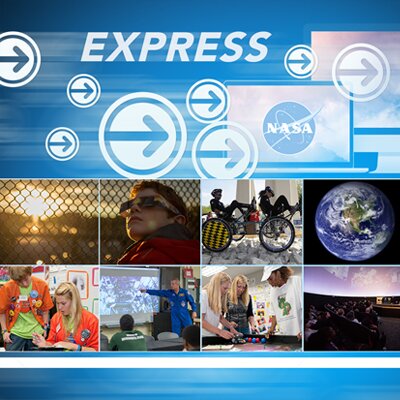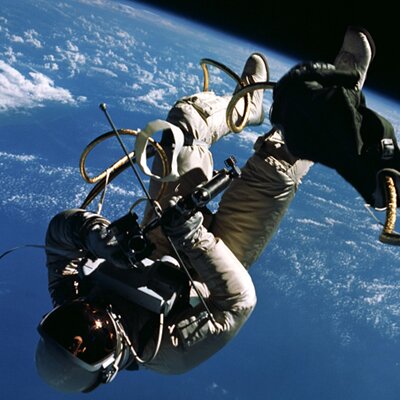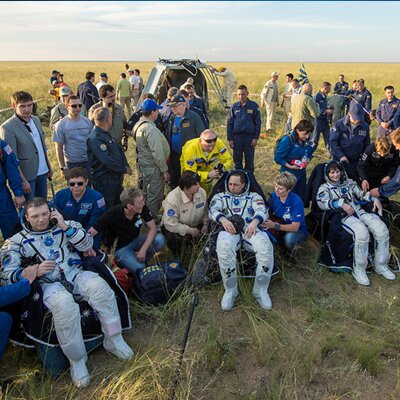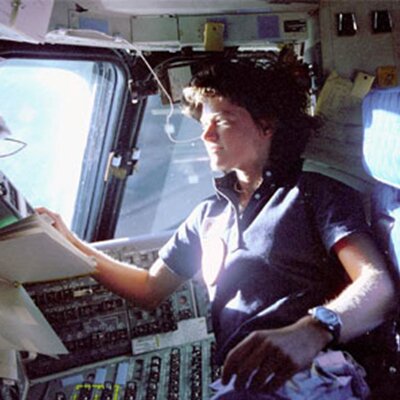|
|
|
 |
Mars' seasonal cap of carbon dioxide ice has eroded many beautiful terrains as it sublimates (goes directly from ice to vapor) every spring. In the region where the High Resolution Imaging Science Experiment (HiRISE) camera on NASA's Mars Reconnaissance Orbiter took this image on Feb. 4, 2009, we see troughs that form a starburst pattern.
To check the image in High-Res, follow the link: http://www.nasa.gov/mission_pages/MRO/multimedia/mro20090325b.html.
|
 |
Tropical Storm Pali, an out-of-season storm for the Central Pacific Ocean, continues to thrive about 8 degrees latitude north of the Equator. A recent infrared image from the GOES-West satellite showed that Pali a small cyclone. NOAA's GOES-West satellite provided an infrared image of Pali on Jan. 11 at 1500 UTC (10 a.m. EST) that showed the storm far to the southwest of Hawaii in the Central Pacific Ocean. Strongest thunderstorms appeared to be around the center of circulation and south and east of the center. The image was created at NASA/NOAA's GOES Project at NASA's Goddard Space Flight Center in Greenbelt, Maryland.
To read more follow the link: http://www.nasa.gov/feature/goddard/2016/pali-central-pacific.
|
 |
- We train for ~2 years before launching to space... And practice our spacewalks underwater 4-10 times, depending on complexity. #askNASA
- Our space suits are modular and sized & re-sized to the crewmember. There are only 12 EMUs in our inventory, 4 in space. #askNASA
- We plan for 6.5-hour spacewalks. We're limited by our life-support systems in the suit. #askNASA
- The 'EMU' spacewalking suit weighs ~350lbs/160kgs, 'weightless' in space but mass is still very real & true, as is 'F=ma' #askNASA
- Spacewalking? It never seems to be 'old hat'. I learned early on that in space there seems to be a surprise around every corner. #askNASA
- Before a spacewalk, we eat relatively 'light', usually a protein bar, granola, and some fruit. #askNASA
- If we get thirsty, we wear a drink bag inside of our spacesuit. It has a straw with a 'bite valve' that allows ready access to water. #askNASA
- The ISS and spacewalkers are vulnerable to micro-meteorite debris. Our EMU suits have 7 layers of shielding. #askNASA
- It's very easy to move about in the vacuum of space! A spacewalk is like 'fingertip ballet', but 'F=ma' still. #askNASA
- What about bathroom breaks? (We're practical people) Spacewalkers wear a 'MAG' - Maximum Absorbency Garment. #askNASA
- Describing how it feels to be in a spacesuit outside the space station, Spacewalking is a visual & emotional 'feast for the senses'! #askNASA
- Astronauts read stories for kids from the Cupola of the ISS in space to kids on earth
To read more, follow the link: http://www.nasa.gov/feature/12-facts-to-make-you-feel-like-an-astronaut-on-a-spacewalk.
|
 |
Jason-3 is the newest satellite in a series designed to maintain long-term satellite altimetry observations of global sea surface height. These data provide critical ocean information that forecasters need to predict devastating hurricanes and severe weather before they arrive onshore. Over the long term, Jason-3 will help us to track global sea level rise, an increasing threat to the resilience of coastal communities and to the health of our environment.
Jason-3’s highly accurate altimetry measurements will be used for a variety of scientific, commercial and operational applications, including:
• Hurricane intensity forecasting
• Surface wave forecasting for offshore operators
• Forecasting tides and currents for commercial shipping and ship routing
• Coastal forecasting for response to environmental problems like oil spills and harmful algal blooms
• Coastal modeling crucial for marine mammal and coral reef research
• El Niño and La Niña forecasting
To find out more, follow the link: http://www.nesdis.noaa.gov/jason-3/index.html.
|
 |
On Tuesday, August 25, 2015, the space station crew opened the hatches to the Japanese resupply ship, HTV-5, and began unloading important supplies and science equipment. The spacecraft, dubbed the “white stork” in Japanese, delivered more than 4 tons of equipment, supplies, and experiments to the space station including an electron telescope, miniature satellites, and a new external platform for ISS science.
To find all the details on the HTV-5’s important delivery, follow the link: http://1.usa.gov/1J50AQ9.
|
 |
This August, hundreds of innovative middle school students from across the country participated in an exciting robotics competition that culminated in a live tournament refereed by astronauts on the space station. The Zero Robotics Middle School Program is an exciting five-week program that introduces students to computer programming, robotics, and engineering by coding free flying satellites that are operated on the ISS. This year, the Massachusetts team took home the top prize. CASIS proudly sponsors the Zero Robotics program and the CASIS Education team was on hand at Kennedy Space Center in Florida to hang out with the FL middle school students participating in the tournament.
Recap all the action in the event photo album here: https://flic.kr/s/aHskfCWRf5.
|
| |
The Smithsonian National Air and Space Museum features 30 minute live interactive webcasts that engage middle school students in a wide range of STEM topics. During the live webcasts you can chat with experts, submit your questions, and discover related content. Even if you aren’t able to catch the live show, the archive is filled with lots of great content!
Find it here: http://s.si.edu/1Jmja7f.
|
 |
The NASA Education EXPRESS weekly bulletin features updates from NASA and STEM associates about workshops, internships, and fellowships; applications for grants or collaborations; promotions for student and educator opportunities; online professional development; and other announcements. See the latest installment here: http://blogs.nasa.gov/educationexpress/.
|
 |
The Japan Aerospace Exploration Agency (JAXA) Kounotori 5 H-II Transfer Vehicle (HTV-5) is seen berthed to the International Space Station. The external CALET experiment, which will search for signatures of dark matter, is seen being extracted from the unpressurized section by the station's robotic arm, Canadarm2. The unpiloted cargo craft, named "Kounotori," which is Japanese for "white stork," is loaded with more than four-and-a-half tons of research and supplies, including water, spare parts and experiment hardware. (Photo Credit: NASA).
|
 |
Would you like to taste a ‘space salad’ someday? The Expedition 44 crewmembers on the International Space Station sampled some space grown lettuce this week, and it marks the first time ever that astronauts have eaten something that was grown and harvested in space!
Follow the link to watch the space station crew munching on their historic lunch and to better understand why this is so important: https://youtu.be/Yp6zLISoT0k.
|
 |
Did you know that instruments installed on the space station are helping researchers measure Typhoon Soudelor?
The RapidScat instrument on the space station has gathered surface wind speed and direction data on Typhoon Soudelor, which is helping scientists on Earth effectively monitor the intensity of the typhoon.
For the latest NASA updates on Typhoon Soudelor and to get a glimpse at how space station technology is impacting Earth science, follow the link: http://1.usa.gov/1IEHwYA.
|
 |
A pair of Russian cosmonauts, Expedition 44 Commander Gennady Padalka and Flight Engineer Mikhail Kornienko, ventured outside of the space station on Monday, August 10, for a 6-hour spacewalk that involved rigging the Russian segment of the space station with new equipment and performing a detailed inspection of portions of the station’s exterior.
For more details on the Russian spacewalk, visit: http://1.usa.gov/1Tll8id.
|
| |
The NASA Education EXPRESS weekly bulletin features updates from NASA and STEM associates about workshops, internships, and fellowships; applications for grants or collaborations; promotions for student and educator opportunities; online professional development; and other announcements. See the latest installment here: http://blogs.nasa.gov/educationexpress/.
|
 |
The Soyuz TMA-17M rocket launches from the Baikonur Cosmodrome in Kazakhstan, as seen in this long exposure, on Thursday, July 23, 2015 carrying Expedition 44 Soyuz Commander Oleg Kononenko of the Russian Federal Space Agency (Roscosmos), Flight Engineer Kjell Lindgren of NASA, and Flight Engineer Kimiya Yui of the Japan Aerospace Exploration Agency (JAXA) into orbit to begin their five month mission on the International Space Station. (Photo Credit: NASA/Aubrey Gemignani).
|
 |
This year, NASA celebrates fifty years of extravehicular activity, otherwise known as spacewalks!
On June 3, 1965, Gemini IV Astronaut Ed White became the first American to conduct a spacewalk. Since that historic day, spacewalks have continued to capture our fascination and aided in our endeavors in space.
Visit www.nasa.gov/suitup to learn everything you need to know about spacewalks and spacesuits!
|
 |
The NASA Education EXPRESS bulletin features updates from NASA and STEM associates about workshops, internships, and fellowships; applications for grants or collaborations; promotions for student and educator opportunities; online professional development; and other announcements.
View the latest Education Express here: http://blogs.nasa.gov/educationexpress/
|
 |
On June 11, 2015 the Expedition 42/43 crew returned to Earth after spending 199 days living and working on the International Space Station. Expedition 43 Commander Terry Virts of NASA, Samantha Cristoforetti of ESA and Anton Shkaplerov of Roscosmos landed their Soyuz TMA-15M spacecraft in Kazakhstan, bringing equipment and research samples back with them as well.
Read more about the crew’s return here: http://1.usa.gov/1KqRumR
View photos from the Soyuz TMA-15M landing here: https://flic.kr/s/aHskdWaS5N
|
 |
Sally Ride was the first American woman in space and a pioneer for women in STEM. Did you also know she was an author or that she was inducted into the Astronaut Hall of Fame?
Learn more about this legendary space explorer here: http://1.usa.gov/1LAJ3EJ
|
|
|
|
|
|
|
© CASIS Academy 2015. ® All Rights Reserved.
|